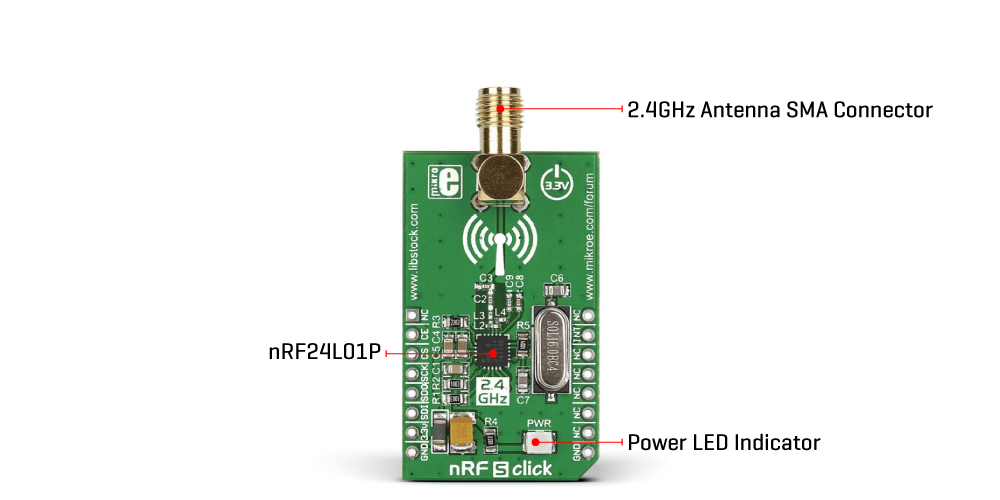OFF
GO LOCAL
| Company | Stock | Price |
|---|---|---|

MIKROE-1836
29 g
Status:
nRF S Click is a compact add-on board that contains a complete RF digital data transceiver. This board features the nRF24L01P, a low-power, high-performance 2.4GHz GFSK transceiver from Nordic Semiconductors. The nRF24L01P transceiver is configurable through the SPI serial interface and operates with only 3.3V in the worldwide ISM frequency band from 2400MHz to 2525MHz. The embedded packet processing engines enable their entire operation with a simple MCU as a radio system. Burst mode transmission and up to 2Mbps air data rate make it suitable for ultra-low power consumption applications. This Click board™ is ideal for home appliances, remote control applications, consumer electronics, and more.
nRF S Click is supported by a mikroSDK compliant library, which includes functions that simplify software development. This Click board™ comes as a fully tested product, ready to be used on a system equipped with the mikroBUS™ socket.
This product is no longer in stock
Availability date:
OFF
| Company | Stock | Price |
|---|---|---|

nRF S Click is based on the nRF24L01P, a low-power, high-performance 2.4GHz GFSK transceiver operating in the worldwide ISM frequency band from 2400MHz up to 2527MHz from Nordic Semiconductors. The nRF24L01P is either a transmitter or receiver with an embedded baseband protocol engine, Enhanced ShockBurst™, over an SMA connector and 2.4GHz SMA antenna is offered by Mikroe. The air data rate supported by nRF24L01P is configurable up to 2Mbps and is combined with two power-saving modes, making nRF S Click very suitable for ultra-low power designs. The embedded packet processing engines enable their entire operation with a simple MCU as a radio system. Auto packet handling, auto retransmission, and auto acknowledgment give reliable links without MCU interference.

The nRF24L01P has a user-defined built-in state machine and four operational modes: Power Down, Standby (I and II), and RX/TX. A transmitter and a receiver must be programmed with the same RF channel frequency to communicate with each other supporting a programmable air data rate of up to 2Mbps. The radio front end uses GFSK modulation and has user-configurable parameters like frequency channel, output power, and air data rate. Internal voltage regulators ensure a high Power Supply Rejection Ratio (PSRR) and a wide power supply range, although nRF S Click is 3.3V only.
The nRF S Click uses an SPI serial interface to communicate with the host MCU. An interrupt pin INT acts as a maskable active-low state interrupt used to set autonomous modes where the internal state machine controls the events (each autonomous mode/sequence is ended with an interrupt). The first Standby mode is defined by the low logic state on the chip enable pin, routed to the RST pin of the mikroBUS™ socket, while the other modes are defined by configurable PWR_UP and PRIM_RX registers.
This Click board™ can only be operated with a 3.3V logic voltage level. The board must perform appropriate logic voltage level conversion before using MCUs with different logic levels. However, the Click board™ comes equipped with a library containing functions and an example code that can be used as a reference for further development.
Type
2.4 GHz Transceivers
Applications
Can be used for home appliances, remote control applications, consumer electronics, and more
On-board modules
nRF24L01P - GFSK transceiver operating in the worldwide ISM frequency band from Nordic Semiconductors
Key Features
Worldwide 2.4GHz ISM band operation, selectable data rate, low power consumption, SMA antenna connection, Enhanced ShockBurst™ baseband protocol engine, SPI interface, automatic packet handling, and more
Interface
GPIO,SPI
Feature
No ClickID
Compatibility
mikroBUS™
Click board size
M (42.9 x 25.4 mm)
Input Voltage
3.3V
This table shows how the pinout on nRF S Click corresponds to the pinout on the mikroBUS™ socket (the latter shown in the two middle columns).
| Label | Name | Default | Description |
|---|---|---|---|
| LD1 | PWR | - | Power LED Indicator |
| Description | Min | Typ | Max | Unit |
|---|---|---|---|---|
| Supply Voltage | - | 3.3 | - | V |
| Operating Frequency Range | 2400 | - | 2527 | MHz |
| Air Data Rate | - | - | 2 | Mbps |
NOTE: Please be advised that any peripheral devices or accessories shown connected to the Click board™ are not included in the package. Check their availability in our shop or in the YMAN section below.